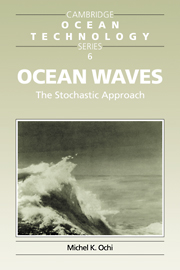Book contents
- Frontmatter
- Contents
- Preface
- 1 Description of random seas
- 2 Spectral analysis
- 3 Wave amplitude and height
- 4 Wave height and associated period
- 5 Sea severity
- 6 Estimation of extreme wave height and sea state
- 7 Directional characteristics of random seas
- 8 Special wave events
- 9 Non-Gaussian waves (waves in finite water depth)
- Appendix A Fundamentals of probability theory
- Appendix B Fundamentals of stochastic process theory
- Appendix C Fourier transform and Hilbert transform
- References
- Index
7 - Directional characteristics of random seas
Published online by Cambridge University Press: 15 October 2009
- Frontmatter
- Contents
- Preface
- 1 Description of random seas
- 2 Spectral analysis
- 3 Wave amplitude and height
- 4 Wave height and associated period
- 5 Sea severity
- 6 Estimation of extreme wave height and sea state
- 7 Directional characteristics of random seas
- 8 Special wave events
- 9 Non-Gaussian waves (waves in finite water depth)
- Appendix A Fundamentals of probability theory
- Appendix B Fundamentals of stochastic process theory
- Appendix C Fourier transform and Hilbert transform
- References
- Index
Summary
INTRODUCTION
Wave spectra discussed in earlier chapters represent wave energy at a certain location in the ocean where the wave energy is an accumulation of the energy of all waves coming from various directions. The spectrum may therefore be called the point spectrum. The spectral analyses and prediction methods of wave heights and periods presented in the preceding chapters assume that wave energy is traveling in a specific direction, commonly considered the same direction as the wind. In this respect, the wave spectrum may be considered as a uni-directional spectrum.
In reality, however, wind-generated wave energy does not necessarily propagate in the same direction as the wind; instead, the energy usually spreads over various directions, though the major part of the energy may propagate in the wind direction. Thus, for an accurate description of random seas, it is necessary to clarify the spreading status of energy. The wave spectrum representing energy in a specified direction is called the directional spectrum, denoted by S(ω, θ).
Information on wave directionality is extremely significant for the design of marine systems such as ships and ocean structures. This is because the responses of a system in a seaway computed using a unidirectional wave spectrum are not only overestimated but the associated coupled responses induced by waves from other directions are also disregarded.
- Type
- Chapter
- Information
- Ocean WavesThe Stochastic Approach, pp. 175 - 217Publisher: Cambridge University PressPrint publication year: 1998



